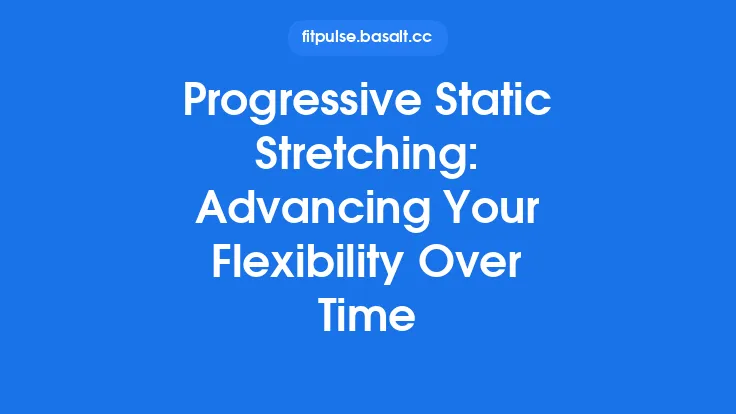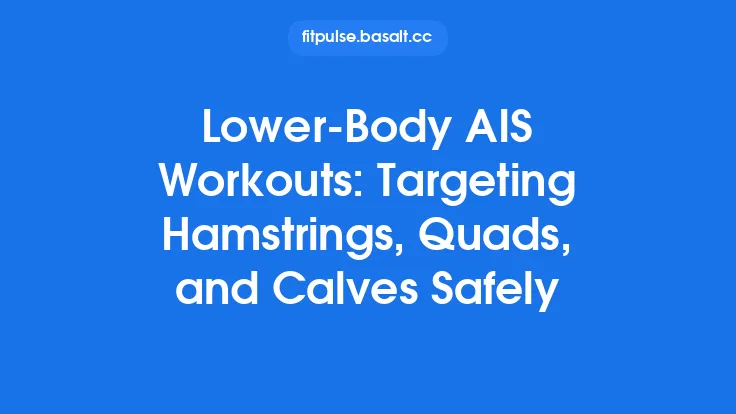When it comes to improving flexibility, Active Isolated Stretching (AIS) is often praised for its ability to increase range of motion while keeping muscles “alive” and ready for movement. Many practitioners assume that a full‑body stretch routine requires straps, blocks, or other accessories, but the essence of AIS is actually rooted in how you move and hold the stretch—not in the tools you use. By leveraging only your own bodyweight, you can create the precise, controlled tension that AIS demands, making the method accessible anywhere—from a hotel room to a park bench. This article walks you through the underlying concepts, the biomechanics of bodyweight‑only AIS, and a practical framework for executing effective stretches without any equipment.
Understanding the Core Principles of AIS Without Equipment
Active vs. Passive Tension
AIS distinguishes itself by emphasizing active tension: you contract the target muscle while it is being gently lengthened. This contrasts with passive stretching, where the muscle is simply placed in a lengthened position and left to relax. The active component stimulates proprioceptors (muscle spindles and Golgi tendon organs), which in turn promote a protective reflex that allows a greater stretch without triggering the stretch‑reflex inhibition that often limits passive stretches.
Isolation Through Small, Controlled Movements
The “isolated” aspect of AIS refers to the brief, 2‑second stretch followed by an immediate return to the starting position. By keeping each stretch short, you avoid the buildup of tension that can cause the muscle to “lock up.” When you repeat this micro‑cycle 8‑10 times, the cumulative effect is a gradual increase in length while the muscle remains engaged.
The 10‑Second Rule
Traditional AIS protocols recommend holding each stretch for no longer than 10 seconds. This time frame is long enough to allow the muscle spindle to adapt but short enough to prevent the protective reflex from kicking in. When you’re using only bodyweight, the 10‑second rule becomes a reliable cue for pacing each repetition.
The Role of Bodyweight in Creating Isolated Stretch Stimuli
Your own mass provides a natural, adjustable load. By shifting your center of gravity, altering limb angles, or using the floor as a stable anchor, you can fine‑tune the amount of stretch pressure without external devices.
| Bodyweight Lever | How It Modifies Stretch Intensity |
|---|---|
| Joint Angle | Small changes (5‑10°) dramatically affect muscle length. |
| Leverage | Extending the lever arm (e.g., straightening the leg) increases the stretch force. |
| Contact Surface | Pressing a foot or hand into the floor creates a counter‑force that can be modulated by weight distribution. |
| Dynamic Shift | Slightly rocking forward or backward while maintaining tension adds a gentle oscillation that deepens the stretch without over‑loading. |
Because these variables are under your direct control, you can progress from a very gentle stretch (e.g., a slight knee bend) to a more demanding one (e.g., a full leg extension) simply by adjusting your posture.
Setting Up a Safe Space: Floor, Mat, and Simple Props
Even though the focus is on “equipment‑free,” a few low‑cost items can improve comfort and safety without altering the core mechanics of AIS.
- Floor Surface – A firm, non‑slippery surface (hardwood, carpet, or a yoga mat) provides a stable base for the bodyweight lever. Avoid overly soft surfaces that compress under weight, as they can reduce the effective stretch force.
- Towel or Small Blanket – Placed under the forearms, shins, or heels, a towel can protect joints and allow a slight elevation that changes the angle of stretch without adding external resistance.
- Wall or Doorframe – While technically a structural element, using a wall as a reference point (e.g., pressing the back of the hand against it) helps maintain alignment and can serve as a “fixed” anchor for certain stretches.
The key is to keep the environment simple: the only “tool” you’re truly using is your own body.
Key Movements and Positions for Equipment‑Free AIS
Below is a curated list of bodyweight‑only AIS stretches that target major muscle groups. Each description follows the AIS template: Start → Activate → Stretch → Return. Perform each micro‑cycle for 2 seconds of active stretch, then return to the start position for 2 seconds, repeating 8‑10 times before moving to the next stretch.
1. Standing Hamstring Isolation
- Start: Stand tall, feet hip‑width apart. Place one heel on a low step or a sturdy book (height should be low enough to keep the knee slightly bent).
- Activate: Gently contract the hamstring of the lifted leg (think of pulling the heel toward the glutes).
- Stretch: While maintaining the contraction, slowly hinge at the hips, allowing the torso to move toward the raised heel. Keep the back neutral.
- Return: Return to upright, releasing the contraction.
Tip: Adjust the height of the support to modulate intensity. A lower platform yields a milder stretch; a higher one increases leverage.
2. Supine Quadriceps Isolation
- Start: Lie on your back with knees bent, feet flat on the floor.
- Activate: Contract the quadriceps of one leg (imagine pulling the knee toward the chest).
- Stretch: While the quad remains contracted, slowly straighten the leg, allowing the heel to lift off the floor. Keep the lower back pressed into the mat.
- Return: Bend the knee back to the starting position, releasing the contraction.
Tip: If the heel lifts too high, place a folded towel under the knee to reduce the lever arm.
3. Seated Hip Flexor Isolation
- Start: Sit on the floor with one leg extended straight and the other leg bent, foot flat against the inner thigh of the extended leg.
- Activate: Engage the hip flexor of the extended leg (imagine pulling the thigh toward the torso).
- Stretch: While maintaining activation, gently lean forward from the hips, keeping the spine neutral, until a mild stretch is felt in the front of the hip.
- Return: Sit upright, releasing the contraction.
Tip: To increase stretch, slide the foot of the bent leg slightly forward, lengthening the distance between the hips and the extended foot.
4. Prone Upper Back Isolation (No Equipment)
- Start: Lie face‑down on the floor, arms extended overhead, palms together.
- Activate: Squeeze the shoulder blades together (scapular retraction).
- Stretch: While maintaining scapular retraction, gently lift the chest off the floor a few centimeters, creating a stretch across the thoracic extensors.
- Return: Lower the chest back to the floor, releasing the contraction.
Tip: Keep the neck neutral; avoid excessive head extension.
5. Standing Calf Isolation
- Start: Stand near a wall for balance, feet hip‑width apart. Shift weight onto one leg, keeping the other foot lightly touching the floor.
- Activate: Contract the gastrocnemius of the weight‑bearing leg (imagine pulling the ball of the foot toward the shin).
- Stretch: While maintaining activation, slowly dorsiflex the ankle (bring the toes toward the shin) to stretch the calf.
- Return: Plant the foot back flat, releasing the contraction.
Tip: To intensify, rise onto the ball of the foot before dorsiflexing, increasing the lever arm.
Sequencing Your Bodyweight AIS Session
A logical flow helps maintain the “active” quality of each stretch and prevents premature fatigue of a particular muscle group.
- Warm‑up the Nervous System – Begin with 2‑3 minutes of low‑intensity movement (e.g., marching in place, gentle arm circles). This primes the proprioceptive system without entering the realm of a full warm‑up routine, which is covered elsewhere.
- Large‑Joint, Multi‑Muscle Stretches – Start with movements that involve multiple joints (e.g., standing hamstring isolation) to engage a broader neuromuscular network.
- Single‑Joint, Targeted Stretches – Progress to more isolated actions such as the supine quadriceps or seated hip flexor stretches.
- Finisher: Postural Stretches – End with stretches that address postural muscles (e.g., prone upper back isolation) to promote balanced tension throughout the day.
Each stretch should be performed for 8‑10 repetitions, respecting the 2‑second active hold and 2‑second return cadence. A brief 15‑second transition between stretches is sufficient to reset the nervous system and adjust positioning.
Managing Intensity and Duration for Optimal Gains
Because AIS relies on repeated micro‑stretches, the perceived intensity is often lower than that of a static hold, yet the cumulative effect can be substantial. Here are three levers you can adjust without adding equipment:
| Lever | How to Adjust | Effect on Stretch |
|---|---|---|
| Joint Angle | Slightly increase the angle of extension or flexion each cycle. | Gradually raises tension, encouraging further lengthening. |
| Leverage Length | Extend the limb farther from the pivot point (e.g., straighten the leg more). | Increases mechanical advantage, amplifying stretch force. |
| Oscillation | Add a subtle forward‑backward sway during the 2‑second hold. | Enhances muscle spindle desensitization, allowing deeper stretch without reflex contraction. |
A practical rule of thumb: if you can maintain the active contraction without feeling a sharp pull or loss of form, you are within a safe intensity range. If the stretch feels “hard” or you lose alignment, reduce the lever or angle slightly.
Integrating Breathing and Neuromuscular Activation
Breath is a powerful modulator of muscle tone. In AIS, synchronizing inhalation with the activation phase and exhalation with the stretch phase helps keep the central nervous system relaxed, allowing the muscle spindle to adapt more readily.
- Inhale – As you contract the target muscle, fill the lungs fully. This creates intra‑abdominal pressure that stabilizes the spine and supports the active contraction.
- Exhale – During the 2‑second stretch, release the breath slowly through the nose or mouth. The exhalation cue encourages a gentle relaxation of surrounding antagonists, facilitating a smoother stretch.
Practicing this breath pattern consistently trains the body to associate the stretch with a calm, controlled state, which is essential for long‑term flexibility gains.
Adapting the Method for Different Flexibility Levels
Because AIS is built on micro‑cycles, it naturally scales across a wide spectrum of flexibility. Below are three adaptation pathways:
- Beginner – Use a modest lever (e.g., keep the knee slightly bent in the hamstring stretch) and limit repetitions to 6 per set. Focus on mastering the activation‑release rhythm.
- Intermediate – Increase the lever length (straighten the leg fully) and add a light oscillation (a gentle rocking motion) while maintaining the 2‑second hold.
- Advanced – Incorporate a “progressive overload” by adding a second micro‑cycle that slightly exceeds the previous range (e.g., a few extra centimeters of extension) before returning to the original position. This creates a subtle “stretch‑over‑load” without external weight.
The key is to progress gradually; the body’s neuromuscular system adapts best when changes are incremental and consistent.
Frequently Asked Questions About Equipment‑Free AIS
Q: Can I perform AIS on a carpeted floor?
A: Yes, as long as the surface is stable and does not compress significantly under your weight. A thin yoga mat works well on carpet, providing a non‑slippery base.
Q: Do I need a partner for any of the stretches?
A: No. All the movements described rely solely on your own bodyweight and the floor or a wall for support. Partner assistance is optional and typically used for deeper passive stretches, which falls outside the scope of pure AIS.
Q: How often should I repeat an AIS session?
A: While frequency guidelines belong to program design, a practical approach is to incorporate a short AIS routine (5‑10 minutes) 2‑3 times per week, especially on days when you anticipate higher physical demands.
Q: Will AIS replace my regular mobility work?
A: AIS complements other mobility techniques. Because it emphasizes active tension, it can be particularly useful for maintaining functional range of motion without sacrificing muscular readiness.
Q: Is there a risk of injury using only bodyweight?
A: The risk is low when the 2‑second hold, 10‑second total stretch limit, and proper alignment are respected. The micro‑stretch nature of AIS inherently reduces the likelihood of overstretching compared to prolonged static holds.
By harnessing the principles of Active Isolated Stretching and applying them through thoughtful bodyweight mechanics, you can achieve meaningful flexibility improvements anywhere, anytime. The method’s reliance on precise activation, brief holds, and controlled movement makes it uniquely suited for travelers, busy professionals, and anyone who prefers a minimalist approach to mobility. Embrace the simplicity of your own body as the tool, and let the micro‑cycles of AIS guide you toward a more supple, resilient physique.





